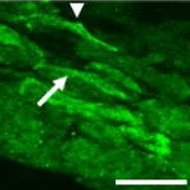
GTX10410 ICC/IF Image
PGP9.5 antibody

GTX10410
ApplicationsImmunoFluorescence, ImmunoCytoChemistry, ImmunoHistoChemistry, ImmunoHistoChemistry Frozen
Product group Antibodies
ReactivityHuman, Mouse, Rat
Overview
- SupplierGeneTex
- Product NamePGP9.5 antibody
- Delivery Days Customer10
- ApplicationsImmunoFluorescence, ImmunoCytoChemistry, ImmunoHistoChemistry, ImmunoHistoChemistry Frozen
- CertificationResearch Use Only
- ClonalityPolyclonal
- HostGuinea Pig
- IsotypeIgG
- Scientific DescriptionThe protein encoded by this gene belongs to the peptidase C12 family. This enzyme is a thiol protease that hydrolyzes a peptide bond at the C-terminal glycine of ubiquitin. This gene is specifically expressed in the neurons and in cells of the diffuse neuroendocrine system. Mutations in this gene may be associated with Parkinson disease.[provided by RefSeq, Sep 2009]
- ReactivityHuman, Mouse, Rat
- Storage Instruction2°C to 8°C,-20°C
- UNSPSC12352203
References
- Development of a model system for neuronal dysfunction in Fabry disease. Kaneski CR et al., 2016 Sep, Mol Genet MetabRead more
- Expression of mechanogated two-pore domain potassium channels in mouse lungs: special reference to mechanosensory airway receptors. Lembrechts R et al., 2011 Oct, Histochem Cell BiolRead more
- Somatostatin modulates mast cell-induced responses in murine spinal neurons and satellite cells. Van Op den bosch J et al., 2009 Aug, Am J Physiol Gastrointest Liver PhysiolRead more
- The effect of inflammation on the expression and distribution of the MAS-related gene receptors MrgE and MrgF in the murine ileum. Avula LR et al., 2011 Nov, Histochem Cell BiolRead more
- Voltage-gated delayed rectifier K v 1-subunits may serve as distinctive markers for enteroglial cells with different phenotypes in the murine ileum. Costagliola A et al., 2009 Sep 18, Neurosci LettRead more
